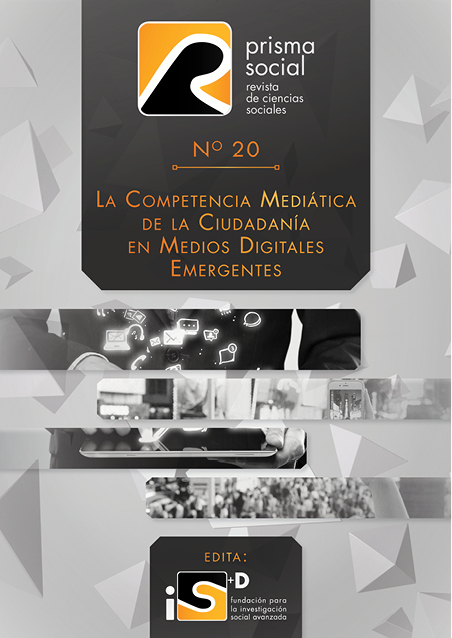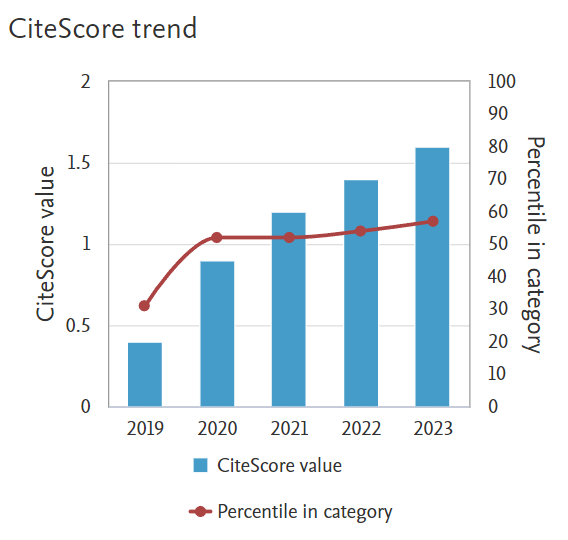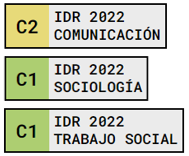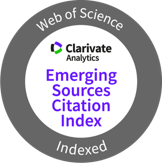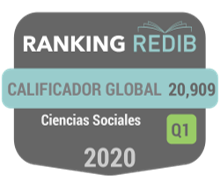Medios móviles emergentes en la enseñanza de lenguas
Palabras clave:
Smartphone, móvil, didáctica, lengua y literatura, enseñanza de lenguasResumen
Los avances tecnológicos y, en concreto la democratización del teléfono inteligente en todos los sectores de la sociedad, han supuesto un cambio en las comunicaciones, tanto en la forma como en el contenido de estas. Este contexto incide de manera importante en la enseñanza, y especialmente en el ámbito de la enseñanza de la lengua, dado que su objeto es el desarrollo de la competencia comunicativa. Desde esta perspectiva, este estudio tiene como objeto conocer los usos e innovaciones educativas que se están llevando a cabo en la enseñanza de lenguas con la utilización del teléfono inteligente, mediante la revisión de la literatura existente. Para ello, se han examinado publicaciones científicas provenientes de bases de datos internacionales de los últimos cinco años, desde 2012 al 2017, relacionadas con los posibles usos del smartphone en el ámbito de la enseñanza de lenguas, según destinatarios, herramientas y resultados de investigación. Los datos muestran un uso mayoritario de los móviles para la enseñanza de lenguas extranjeras, así como en la etapa de educación universitaria, especialmente como componente motivacional y para la corrección de malos hábitos.
Descargas
Citas
Al-Otaibi, HM.; AlAmer, RM., & Al-Khalifa, HS. (2016). The next generation of language labs: Can mobiles help? A case study. Computers in human behavior, 59, 342-349. https://doi.org/10.1016/j.chb.2016.02.028
Alvarado, N.C., Coelho, D., & Dougherty, E. (2016). Mobile apps for ELLs: Supporting language learning with engaging digital tools. Argentinian Journal of Applied Linguistics, 4 (1), 43-58. Recuperado de http://www.faapi.org.ar/ajal/issues/401/Alvarado.html
Andújar-Vaca, A., & Cruz-Martínez, M. (2017). Mobile Instant Messaging: Whatsapp and its Potential to Develop Oral Skills. [Mensajería instantánea móvil: Whatsapp y su potencial para desarrollar las destrezas orales]. Comunicar, 50, 43-52. https://doi.org/10.3916/C50-2017-04
Baglama, B., Yikmis, A., & Demirok, M. S. (2017). Special education teachers’views on using technology in teaching mathematics. European Journal of Special Education Research, 2(5), 120-134. Recuperado de https://oapub.org/edu/index.php/ejse/article/view/936
Baskan, G. A., & Ozcan, D. (2011). Current tendencies in curriculum and instruction studies presented in World Conferences on Educational Sciences. Procedia: Social and Behavioral Sciences, 15, 4005-4012. https://doi.org/10.1016/j.sbspro.2011.04.405
Berns, A., Palomo-Duarte, M., Isla-Montes, J-L., Dodero-Beardo, J-M., & Delatorre, P. (2017). Agenda colaborativa para el aprendizaje de idiomas: del papel al dispositivo móvil. RIED. Revista Iberoamericana de Educación a Distancia, 20(2), 119-139. http://dx.doi.org/10.5944/ried.20.2.17713
Bicen, H., & Uzunboylu, H. (2013). The use of social networking sites in education: A case study of Facebook. Journal of Universal Computer Science, 19(5), 658-671. http://dx.doi.org/10.3217/jucs-019-05-0658
Bradley, L., Lindstrom, NB., & Hashemi, SS. (2017). Integration and Language Learning of Newly Arrived Migrants Using Mobile Technology. Journal of Interactive Media in Education, (1). http://doi.org/10.5334/jime.434
Cani, J.B., Pinheiro, I.Q., Santiago, M.E.V., & Soares, G.M. (2017). Análise de jogos digitais em dispositivos móveis para aprendizagem de línguas estrangeiras. Revista Brasileira de Linguistica Aplicada, 17 (3), 455-481. http://doi.org/10.1590/1984-6398201711880
Cantillo, C., Roura, M., & Sánchez, A. (2012). Tendencias actuales en el uso de dispositivos móviles en educación. La Educ@ción, 147. Recuperado de https://goo.gl/rG3Rk8
Cánovas, G., García-de-Pablo, A., Oliaga, A., & Aboy, I. (2014). Menores de Edad y Conectividad Móvil en España: Tablets y Smartphones. Centro de Seguridad en Internet para los Menores en España: PROTEGELES. Recuperado de https://goo.gl/zET5zG
Cassany, D. (2011). Después de Internet… Textos de Didáctica de la Lengua y de la Literatura, 57, 12-22. Recuperado de https://goo.gl/2kifCd
Chai, CS., Wong, LH., & King, RB. (2016). Surveying and Modeling Students' Motivation and Learning Strategies for Mobile-Assisted Seamless Chinese Language Learning. Educational Technology & Society, 19 (3), 170-180. Recuperado de http://www.ifets.info/journals/19_3/16.pdf
Chang, C., Shih, JL., & Chang, CK. (2017). A mobile instructional pervasive game method for language learning. Universal Access in the Information Society,16 (3), 653-665. https://doi.org/10.1007/s10209-016-0496-6
Chen, Y., Carger, C. L., & Smith, T. J. (2017). Mobile-assisted narrative writing practice for young English language learners from a funds of knowledge approach. Language Learning & Technology, 21(1), 28–41. Recuperado de http://llt.msu.edu/issues/february2017/chencargersmith.p
Cheon, J., Lee, S., Crooks, S. M., & Song, J. (2012). An investigation of mobile learning readiness in higher education based on the theory of planned behavior. Computers & Education, 59(3), 1054-1064. https://doi.org/10.1016/j.compedu.2012.04.015
Chóliz, M., Villanueva, V., & Chóliz, M.C. (2009). Ellas, ellos y su móvil: Uso, abuso (¿y dependencia?) del teléfono móvil en la adolescencia. Revista española de drogodependencia, 34 (I), 74-88. Recuperado de http://www.aesed.com/descargas/revistas/v34n1_6.pdf
Comas-Quinn, A., De-los-Arcos, B., & Mardomingo, R. (2012). Virtual learning environments (VLEs) for distance language learning: Shifting tutor roles in a contested space for interaction. Computer Assisted Language Learning, 25 (2), 129-143. https://doi.org/10.1080/09588221.2011.636055
Corbell, J.R., & Valdes-Corbell, M.E. (2007). Are You Ready for Mobile Learning? Educause Quarterly. 51-58. Recuperado de https://er.educause.edu/articles/2007/4/are-you-ready-for-mobile-learning
Crescenzi, L., & Grané, M. (2016). An Analysis of the Interaction Design of the Best Educational Apps for Children Aged Zero to Eight. [Análisis del diseño interactivo de las mejores apps educativas para niños de cero a ocho años]. Comunicar, 46, 77-85. https://doi.org/10.3916/C46-2016-08
Da-Silva, I. P., & Rocha, F.D. (2017). Implications of the use of whatsapp in education. Revista EDaPECI: Educação a Distância e Práticas Educativas Comunicacionais e Interculturais, 17 (2), 161-174. Recuperado de https://seer.ufs.br/index.php/edapeci/article/view/5615/pdf
Elaish, M.M., Shuib, L., Ghani, N.A., Yadegaridehkordi E., & Alaa, M. (2017) Mobile Learning for English Language Acquisition: Taxonomy, Challenges, and Recommendations. IEEE Acces, 5, 19033-19047. https://doi.org/10.1109/ACCESS.2017.2749541
Ferraz, D.M., & Nogarol, I. V. (2016). Letramento digital: os usos dos celulares em aulas de licenciatura em letras - inglês. Revista Tecnologia e Sociedade, 12 (26), 97-114. Recuperado de https://periodicos.utfpr.edu.br/rts/article/view/3998
Fombona, J., & Roza-Martín P. (2016). Uso de los dispositivos móviles en educación infantil. Edmetic, Revista de Educación Mediática y TIC, 5(2), 158-181. https://doi.org/10.21071/edmetic.v5i2.5781
Gajek, E. (2016). Mobile Technologies as Boundary Objects in the Hands of Student Teachers of Languages Inside and Outside the University. International journal of mobile and blended learning, 8 (2), 85-92. http://dx.doi.org/10.4018/IJMBL.2016040107
Garcia-Laborda, J., Magal-Royo, T., Frances-Litzler, M., & Giménez-López; J.L. (2014). Mobile Phones for Spain's University Entrance Examination Language Test. Journal of Educational Technology & Society, 17 (2), 17-30. Recuperado de https://goo.gl/iQFjfS
Gewerc, A., Fraga, F., & Rodés, V. (2017). Niños y adolescentes frente a la Competencia Digital. Entre el teléfono móvil, youtubers y videojuegos. Revista Interuniversitaria de Formación del Profesorado, 89(31.2), 171-186. Recuperado de http://aufop.com/aufop/revistas/arta/impresa/202/2129
Godwin-Jones, R. (2016). Augmented reality and language learning: From annotated vocabulary to place-based mobile games. Language Learning & Technology 20(3), 9–19. Recuperado de http://llt.msu.edu/issues/october2016/emerging.pdf
Gromik, N. A. (2017). The effect of theme preference on academic word list use: A case for smartphone video recording feature. Education and information technologies, 22 (5), 2087-2101. http://dx.doi.org/10.1007/s10639-016-9533-6
Gutiérrez, A., & Tyner, K. (2012). Media Literacy in Multiple Contexts. [Alfabetización mediática en contextos múltiples]. Comunicar, 38, 10-12. https://doi.org/10.3916/C38-2012-02-00
Hwang, W.Y., Chen, H.S.L., Shadiev, R., Huang, R.Y.M., & Chen, C.Y. (2014). Improving English as a foreign language writing in elementary schools using mobile devices in familiar situational contexts. Computer Assisted Language Learning, 27(5), 359-378. http://dx.doi.org/10.1080/09588221.2012.733711
INE (2017). Encuesta sobre equipamiento y uso de tecnologías de información y comunicación en los hogares. Recuperado de https://goo.gl/XAxoca
Jones, C., Ramanau, R., Cross, S., & Healing, G. (2010). Net generation or Digital Natives: Is there a distinct new generation entering university? Computers & Education, 54(3), 722-732.
Ketyi, A. (2016). From Mobile Language Learning to Gamification: an Overlook of Research Results with Business Management Students over a Five-Year Period. Porta Linguarum. Revista Internacional de Didáctica de las Lenguas Extranjeras, I, 45-60. Recuperado de http://www.ugr.es/~portalin/articulos/PL_monograph1_2016/art_4.pdf
Khansarian-Dehkordi, F., & Ameri-Golestan, A. (2016). Long term effects of mobile learning on persian speaking english language learners' vocabulary acquisition. Modern Journal of Language Teaching Methods, 6 (4), p. 140-150. Recuperado de http://mjltm.org/files/cd_papers/r_23_170607223843.pdf
Kondo, M., Ishikawa, Y., Smith, C., Sakamoto, K., Shimomura, H., & Wada, N. (2012). Mobile assisted language learning in university EFL courses in japan: Developing attitudes and skills for self-regulated learning. ReCALL: The Journal of EUROCALL, 24(2), 169-187. http://dx.doi.org/10.1017/S0958344012000055
Kukulska-Hulme, A., & Bull, S. (2009). Theory-based support for mobile language learning: Noticing and recording. International Journal of Interactive Mobile Technologies iJIM, 3(2), 12–18. http://dx.doi.org/10.3991/ijim.v3i2.740
Laborda, J.G., Royo, T.M., Litzler, M.F., & López, J.L. (2014) Mobile phones for Spain's University entrance examination language test. Journal of Educational Technology & Society, 17, (2), 17-30. Recuperado de https://www.jstor.org/stable/jeductechsoci.17.2.17?seq=1#page_scan_tab_contents
Lin, C.C., & Yu, Y.C. (2012). Learning English vocabulary on mobile phones. En J. Colpaert, A. Aerts, W. C. V. Wu, & Y. C. J. Chao, (Eds.), The medium matters - Proceedings from the 15th International CALL Conference (416-420). http://dx.doi.org/10.4018/IJCALLT.2014040104
Liu, M., Navarrete, C.C., & Wivagg, J. (2014). Potentials of mobile technology for K-12 education: An investigation of ipod touch use for english language learners in the United States. Educational Technology and Society, 17(2), 115-126. Recuperado de http://www.ifets.info/journals/17_2/10.pdf
Luo, B.R., Lin, Y.L., Chen, N.S., & Fang, W.C. (2015). Using Smartphone to Facilitate English Communication and Willingness to Communicate in a Communicative Language Teaching Classroom. 15TH IEEE International Conference on Advanced Learning Technologies (ICALT 2015). (320-322). http://dx.doi.org/10.1109/ICALT.2015.22
Mahdi, H.S. (2017). The Use of Keyword Video Captioning on Vocabulary Learning Through Mobile-Assisted Language Learning. International journal of English linguistics, 7 (4), 1-7. https://doi.org/10.5539/ijel.v7n4p1
Marcos, L., Támez, R., & Lozano, A. (2009). Mobile Learning as a Tool for the Development of Communication Skills in Virtual Discussion Boards. [Aprendizaje móvil y desarrollo de habilidades en foros asincrónicos de comunicación]. Comunicar, 33, 93-100. https://doi.org/10.3916/c33-2009-02-009
Milutinovic, M., Bojovic, Z., Labus, A., & Bogdanovic, Z. (2016). Ontology-based generated learning objects for mobile language learning. Computer Science and Information Systems, 13 (2), 493–514. https://doi.org/10.2298/CSIS141030004M
Olson, K.B., Wilkinson C.L., Wilkinson, M.J., Harris, J., & Whittle, A. (2016). Texts for Talking: Evaluation of a Mobile Health Program Addressing Speech and Language Delay. Clinical pediatrics, 55 (11), 1044-1049. https://doi.org/10.1177/0009922816664721
Palomo-Duarte, M., Berns, A., Cejas, A., Dodero, J.M., Caballero, J.A., & Ruiz-Rube, I. (2016). Assessing Foreign Language Learning Through Mobile Game-Based Learning Environments. International Journal of Human Capital and Information Technology Professionals, 7 (2), 53-67. https://doi.org/10.4018/IJHCITP.2016040104
Pérez-Rodríguez, M.A., & Delgado-Ponce, Á. (2017). La educación del deseo: Competencia comunicativa, competencia mediática y publicidad. Textos de Didáctica de la Lengua y la Literatura, 77, 14-21.
Pérez-Rodríguez, M.A., & Delgado-Ponce, Á. (2012). From Digital and Audiovisual Competence to Media Competence: Dimensions and indicators. [De la competencia digital y audiovisual a la competencia mediática: dimensiones e indicadores]. Comunicar, 39, 25-34. https://doi.org/10.3916/C39-2012-02-02
Pérez-Rodríguez, M.A., Delgado-Ponce, Á., García-Ruiz, R., & Caldeiro, M.C. (2016). Niños y jóvenes ante las redes y las pantallas. La educación en competencia mediática. Barcelona: Gedisa.
Quinn, C. (2000). M-Learning. Mobile, Wireless, In-Your-Pocket Learning. LiNE Zine. Recuperado de http://www.linezine.com/2.1/features/cqmmwiyp.htm
Ramírez-Montoya, M.S., & García-Peñalvo, F. (2018). Co-creation and open innovation: Systematic literature review. [Co-creación e innovación abierta: Revisión sistemática de literatura]. Comunicar, 54, 09-18. https://doi.org/10.3916/C54-2018-01
Saidouni, K., & Bahloul, A. (2016). Teachers and Students' Attitudes towards Using Mobile-Assisted Language Learning in Higher Education. Arab world English journal, Special Issue 3, 123-140. Recuperado de http://www.awej.org/images/AllIssues/Specialissues/CALLjuly2016/10.pdf
Santiago, R., & Bárcena, E. (2016). The Potential of Podcasts as a Didactic Resource for the Development of Oral Skills in Second Language with Mobile Devices. Revista Internacional de Didáctica de las Lenguas Extranjeras, I, 61-72. Recuperado de http://www.ugr.es/~portalin/articulos/PL_monograph1_2016/art_5.pdf
Sert, N., & Boynueğri, E. (2017). Digital technology use by the students and English teachers and self-directed language learning. World Journal on Educational Technology: Current Issues, 9(1), 24-34. Recuperado de https://sproc.org/ojs/index.php/wjet/article/view/993
Shadiev, R., Hwang, W.Y., & Huang, Y.M. (2017). Review of research on mobile language learning in authentic environments. Computer Assisted Language Learning, 30 (3-4), 284-303. https://doi.org/10.1080/09588221.2017.1308383
Sharples, M. (2006). Big issues in mobile learning. Report of a workshop by Kaleidoscope Network Excellence Mobile Learning Initiative (41–52). University of Nottingham, UK. Recuperado de http://matchsz.inf.elte.hu/tt/docs/Sharples-20062.pdf
Shi, Z., Luo, G., & Le, H. (2017). Mobile-assisted Language Learning Using WeChat Instant Messaging. International journal of emerging technologies in learning, 12 (02), 16-26. https://doi.org/10.3991/ijet.v12i02.6681
Tarighat, S., & Khodabakhsh, S. (2016). Mobile-Assisted Language Assessment: Assessing speaking. Computers in Human Behavior, 64, 409-413. https://doi.org/10.1016/j.chb.2016.07.014
Torres-Toukoumidis, A., Romero-Rodríguez, L., Pérez-Rodríguez, M. A., & Björk, S. (2016). Desarrollo de habilidades de lectura a través de los videojuegos: Estado del arte. Ocnos: Revista de Estudios sobre Lectura 15 (2), 37-49. https://doi.org/10.18239/ocnos_2016.15.2.1124
Traxler, J., Barcena, E., & García-Laborda, J. (2015). Mobile technology for foreign language teaching: Building bridges between non-formal and formal scenarios. Journal of Universal Computer Science, 21(10), 1234-1247. Recuperado de https://goo.gl/Y1GPuf
Traxler, J.M. (2017). Learning with Mobiles in Developing Countries Technology, Language, and Literacy. International journal of mobile and blended learning, 9 (2), 1-15. https://doi.org/10.4018/IJMBL.2017040101
Troussas, C., Virvou, M., & Alepis, E. (2014). Collaborative learning: Group interaction in an intelligent mobile-assisted multiple language learning system. Informatics in Education 13(2), 279-292. http://dx.doi.org/10.15388/infedu.2014.08
Uzunboylu, H., & Genc, Z. (2017). Analysis of documents published in Scopus database on foreign language learning through mobile learning: A content analysis. Profile: Issues in Teachers’ Professional Development, 19 (Suppl. 1), 99-107. http://dx.doi.org/10.15446/profile.v19n_sup1.68624
Uzunboylu, H., & Tugun, V. (2016). Validity and reliability of tablet supported education attitude and usability scale. Journal of Universal Computer Science, 22(1), 82-93. http://dx.doi.org/10.3217/jucs-022-01-0082
Van-Hove, S., Vanderhoven, E., & Cornillie, F. (2017). The tablet for Second Language Vocabulary Learning: Keyboard, Stylus or Multiple Choice. [La tablet para el aprendizaje de vocabulario en segundas lenguas: teclado, lápiz digital u opción múltiple]. Comunicar, 50, 53-63. https://doi.org/10.3916/C50-2017-05
Wang, Y.H. (2017). Integrating self-paced mobile learning into language instruction: impact on reading comprehension and learner satisfaction. Interactive learning environments, 25 (3), 397-411. https://doi.org/10.1080/10494820.2015.1131170
Wu, P.H., & Marek, M. (2016). Incorporating LINE Smartphone Affordances: Cross-Cultural Collaboration, Willingness to Communicate, and Language Learning. International Journal of Computer-assisted Language Learning and Teaching, 6 (2), 56-73. https://doi.org/10.4018/IJCALLT.2016040104
Yükselir, C. (2017). A Meta-synthesis of Qualitative Research about Mobile Assisted Language Learning (MALL) in Foreign Language Teaching. Arab World English Journal, 8 (3). https://dx.doi.org/10.24093/awej/vol8no3.20
Descargas
Publicado
Cómo citar
Número
Sección
Licencia
Los autores/as que publiquen en esta revista aceptan las siguientes condiciones:
- Los autores/as conservan los derechos de autor.
- Los autores/as ceden a la revista el derecho de la primera publicación. La revista también posee los derechos de edición.
- Todos los contenidos publicados se regulan mediante una Licencia Atribución/Reconocimiento-SinDerivados 4.0 Internacional. Acceda a la versión informativa y texto legal de la licencia. En virtud de ello, se permite a terceros utilizar lo publicado siempre que mencionen la autoría del trabajo y a la primera publicación en esta revista. Si transforma el material, no podrá distribuir el trabajo modificado.
- Los autores/as pueden realizar otros acuerdos contractuales independientes y adicionales para la distribución no exclusiva de la versión del artículo publicado en esta revista (p. ej., incluirlo en un repositorio institucional o publicarlo en un libro) siempre que indiquen claramente que el trabajo se publicó por primera vez en esta revista.
- Se permite y recomienda a los autores/as a publicar su trabajo en Internet (por ejemplo en páginas institucionales o personales), una vez publicado en la revista y citando a la misma ya que puede conducir a intercambios productivos y a una mayor y más rápida difusión del trabajo publicado (vea The Effect of Open Access).

